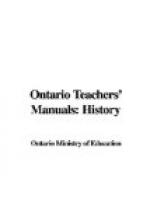The notion of cause and effect does not belong so wholly to the study of history as the notions of time and of the social unit; it is surprising, however, how soon it makes its appearance in the child’s conceptions of history, in his desire to know the “why” of things. (See Barnes’ Studies in Historical Method.)
THE INFORMATION STAGE
There are several questions that children soon come to ask: “When?” and “Where?” “What?” and “Who?” This stage may be said to begin in earnest with the Second Form, and it continues through the whole course. One of the essential elements in history study is to have a knowledge of the important facts of history, without which there can be no inferences of value for present use. The all-important point in this teaching of facts is to keep the lessons interesting and not allow them to become mere lifeless memorizing of isolated happenings; for a fact is of value only when related to other facts. (See pp. 36, 38.)
THE REFLECTIVE STAGE
This stage naturally follows the Information stage, as one must acquire facts before reflecting on them in order to draw inferences. But reflection of a simple kind may begin as soon as any facts are given that will show the relations of cause and effect. The question for the pupil here is “Why?” just as in the preceding stage the questions were “When?” and “Where?” “What?” and “Who?” Information and reflection may therefore be combined—with due regard to the pupil’s capacity.
PRACTICAL DIFFICULTIES
We may speak of two difficulties. The first concerns the enormous amount of historical material that exists. It is increased still more by the intermingling of legend with history and by the partial narratives of prejudiced writers. The legendary part may be taken up in the Story stage; and the evils of one-sided accounts are often balanced by the greater vigour and interest of the narrative, as in Macaulay’s writings. The difficulty connected with the great amount of material can be solved by the selection (already largely made by the text-books) of the more important parts, that is, those facts of history that have the greatest influence on after times—“the points of vital growth and large connection” without which subsequent history cannot be properly understood.
The second difficulty has to do with deciding where to begin the teaching of history. There are two principles of teaching that will help to solve this difficulty: (1) The child learns by relating everything new to his present fund of experiences; (2) A child’s notions grow more complex as his knowledge increases. To apply these, we must know the child’s experiences and his present notions. We cannot assume that the present conditions of social life are known to the child through his experiences. Our social




